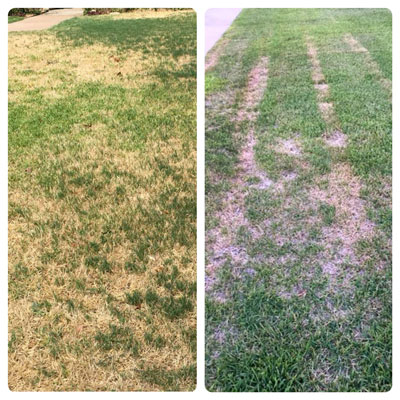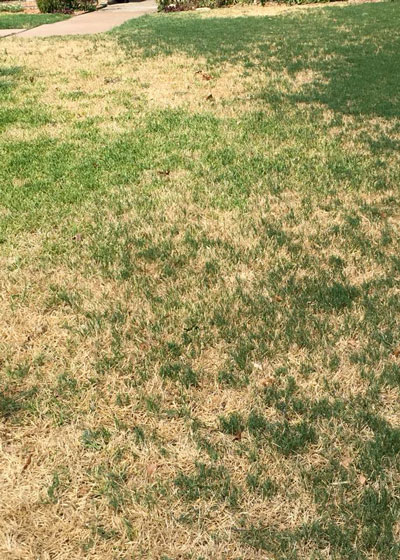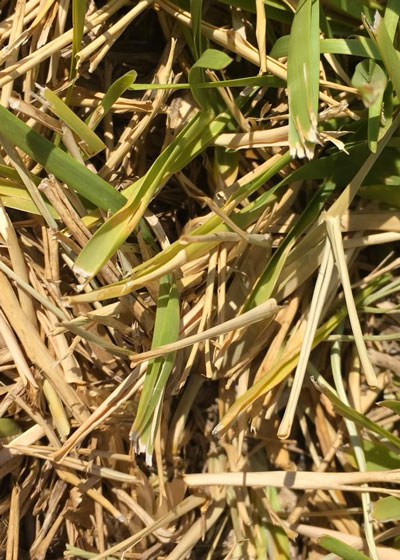Question of the Week: August 9, 2018
“What is wrong with my lawn?”

Chinch bug damage has been rampant this summer (L). Heat tracking is an unusual phenomenon (R).
I honestly don’t believe there’s been a day that’s gone by since late June without someone asking about their St. Augustine drying up and dying. Summer 2018 has been a terrible year for chinch bugs. You know that, because we’ve covered them three times already here in e-gardens. They just keep coming up.

Lawn that has been ravaged by chinch bugs.

Close-up shows how they suck all the moisture out of the turf.
Here’s what I’m observing…
• Because it’s been so hot and dry, chinch bugs have run rampant over our St. Augustine all across Texas. They love heat and sunshine.
• They started earlier than ever, because really hot weather arrived earlier than ever in late May and June.
• There is a large part of the population that is convinced that it’s something else… “a fungus,” for instance. So they treat with a fungicide. “I looked and I didn’t see any chinch bugs,” they tell me.
• Then I find out they haven’t really conducted the forensic search for these pests – they haven’t gotten down on all fours and parted the grass in the declining (not the dead) areas.
• Many people don’t realize that chinch bugs aren’t very big. Little larger than pinheads and maybe as big as a BB. And they’re black, which makes them harder to see. But they do have white lines and diamonds on their wings. And the young ones are red and very active.
• Some people did apply an insecticide but then second-guessed their efforts, wondering if they really had had chinch bugs originally. And the answer is probably yes, especially if the lawn looked like the one in my photo. But by then, if they did decide to get down and look for the insects, to no one’s surprise, they didn’t find any. They had killed them with the insecticide.
• Chinch bug season is just about over. They quit feeding by mid-September. But if you have a current outbreak, and if you haven’t yet treated, they could do huge amounts of damage in those four weeks, so better hop to the insecticide in the next 36 hours. Your local nursery will have several good options. Merit is one example.
• Chinch bugs will be back. Probably next year. Almost assuredly to the same parts of your yard. Learn to recognize them earlier.
When lawn is mowed in extreme heat, grass may be adversely impacted by heat of the wheels.
And then on to the other, less-common question…
“What is causing this unusual striping in my lawn?”
This is certainly not an “FAQ” for me. In fact, when someone else posted a similar photo on my Facebook page a couple of weeks ago, I reposted it and asked my crowd if there might be a professional who knew what caused it. Within an hour someone from Perfect Trim Lawn and Landscape in Keller identified it as “heat tracking” and another FB reader found this article from Michigan State.
This was the original photo posted to my Facebook page, and I have to admit I was puzzled by what might have caused this.
The original photo posted to my page looked like the grass might have grown too tall between mowings and that the clippings might have piled up and suffocated the grass below. But the FB friend assured me they had mowed regularly.
For a moment I even considered the possibility of a gasoline leak, but the pattern was too consistent and the affected area too lengthy.
That was when I decided to repost the photo and ask for help from the 65,000 people on my FB page. There’s a real wealth of information in that community. And that’s when I learned there was an actual name for heat tracking. Now we all know.
So if you’re seeing these stripes, it’s a temporary thing, and it’s probably because you mowed when it was too hot. That’s not good for you, and it’s not good for your grass.
